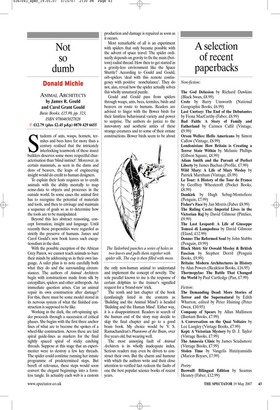Not so dumb
Donald Michie
ANIMAL ARCHITECTS by James R. Gould and Carol Grant Gould Basic Books, £15.99, pp. 323, ISBN 9780465027828 ✆ £12.79 (plus £2.45 p&p) 0870 429 6655 Students of ants, wasps, hornets, termites and bees have for more than a century realised that the intricately interlocking teamwork of these insect builders deserves some more respectful characterisation than ‘blind instinct’. Moreover, in certain mammals, as seen in the dams and dens of beavers, the leaps of engineering insight would do credit to human designers.
To explain their feats requires us to credit animals with the ability mentally to map sense-data to objects and processes in the outside world. In some cases the animal first has to recognise the potential of materials and tools, and then to envisage and maintain a sequence of goals so as to determine how the tools are to be manipulated.
Beyond this lies abstract reasoning, concept formation, insight and language. Until recently these propensities were regarded as strictly the preserve of humans. James and Carol Gould’s new book leaves such exceptionalism in the dust.
With the possible exception of the African Grey Parrot, we cannot teach animals to bare their minds by addressing us in their own language. A safer plan is to note carefully both what they do and the surrounding circumstances. The authors of Animal Architects begin with constructions made from silk by caterpillars, spiders and other arthropods. An immediate question arises. Can an animal repair its own construction after damage? For this, there must be some model stored in its nervous system of what the finished construction is supposed to be like.
Working in the dark, the orb-spinning spider proceeds through a succession of critical phases. She begins with the first three anchor lines of what are to become the spokes of a wheel-like construction. Across these are laid spiral guide-lines as markers for the final tightly spaced spiral of sticky catching threads. Suppose at this stage that an experimenter were to destroy a few key threads. The spider could continue running her innate programme of predetermined steps. But bereft of relevance, these steps would soon convert the elegant beginnings into a formless tangle. In actuality each web is a custom production and damage is repaired as soon as it occurs.
Most remarkable of all is an experiment with spiders that only became possible with the advent of space travel. The spider ordinarily depends on gravity to fix the main (bottom) radial thread. How then to get started in a gravity-less environment like the Space Shuttle? According to Gould and Gould, orb-spiders ‘deal with this remote contingency with positive nonchalance’. They do not, alas, reveal how the spider actually solves this wholly unnatural puzzle.
Gould and Gould pass from spiders through wasps, ants, bees, termites, birds and beavers en route to humans. Readers are advised to linger with the Bower birds for their limitless behavioural variety and power to surprise. The authors do justice to the innovatory and aesthetic antics of these strange creatures and to some of their ornate constructions. Bower birds seem to be about the only non-human animal to understand and implement the concept of novelty. The sole parallel known to me is the response of certain dolphins to the trainer’s signalled request for a ‘brand-new’ trick.
The tenth and last chapter of the book (confusingly listed in the contents as ‘Building and the Animal Mind’) is headed ‘Building and the Human Mind’. Either way, it is a disappointment. Readers in search of the human end of the story may decide to skip the final chapter and go to a good brain book. My choice would be V. S. Ramachandran’s Phantoms of the Brain, over five years old, but wearing well.
The most annoying fault of Animal Architects is its wholly inadequate index. Serious readers may even be driven to construct their own. But the charm and humour with which the authors write and their close attention to verified fact redeem the faults of one the best popular science books of recent years.










































































 Previous page
Previous page